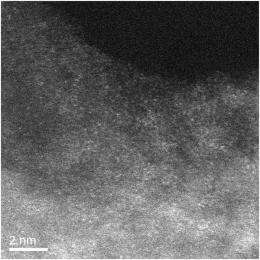Imaging Atoms and Revolutionizing Laptop Computers

(PhysOrg.com) -- Outlet vampires (n). Definition: People with laptop computers who stare hungrily at the walls of airports, train stations, and bus depots, searching for an electrical outlet to power their computer.
Professor Abhaya Datye, Director of the University of New Mexico's Center for Micro-Engineered Materials, is investigating a way to free "outlet vampires" from their troubles.
The idea is simple. Design a battery that lasts 20 hours and runs on methanol or wood-grain alcohol. In this battery, the methanol is transformed into hydrogen, which is then fed into a fuel cell to create electricity. When the battery is spent, you'd simply plug in a fresh methanol cartridge.
But, don't go rushing to the store just yet. This idea, Datye noted at the Pacific Northwest National Laboratory's Frontiers in Catalysis Science and Engineering Seminar Series, relies on researchers finding an affordable catalyst that can quickly and efficiently turn methanol into hydrogen.
Answering questions
Datye is leading research into a catalyst that might do the trick: a combination of palladium and zinc. This bimetallic catalyst is created from affordable metals and effectively transforms methanol. However, for the methanol conversion process to work on a scale sufficient for the needs of future long-life batteries, molecular-level interactions must be understood. For example, does the size and shape of the catalyst matter? Is there a better size to make it work more efficiently? Datye and his colleagues are working to answer these and numerous other questions.
Seeing atoms
Part of their research involves imaging or "seeing" the interactions on the surface of the catalyst using high-powered microscopes and other instruments. To date, they've found that isolated palladium atoms migrate and end up isolated on top of columns of zinc within the zinc oxide structure. The team also found that these structures co-exist with others where zinc and palladium are together in bimetallic particles. The question that remains to be answered is which of these structures does the job better. The answer may provide clues to making more efficient catalysts in the future.
In addition, the team is working to study how the shape of zinc oxide crystals affects reaction rates. "By choosing the right synthesis conditions, you can get surfaces you want," said Datye. "This includes making thin plates or sheets of zinc oxide."
This research was done, in part, using a specialized transmission electron microscope. This microscope was corrected for aberrations in its electron optical components, allowing scientists to take pictures of catalysts and other materials at 0.7 Angstroms resolution. The microscope is available at the Oak Ridge National Laboratory.
Provided by Pacific Northwest National Laboratory
















